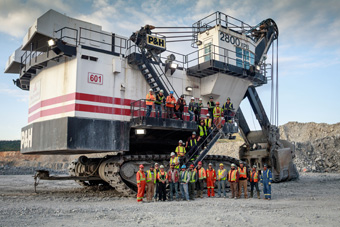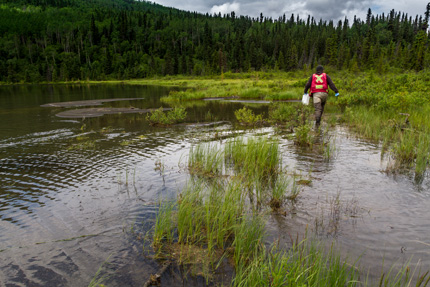- Home
- Corporate
- Operations
- Exploration
- Shareholders
- Careers
- Site Map
- Contact
- Legal Notice
- Privacy Statement
Copyright © 2024
Imperial Metals
All rights reserved.
Imperial Metals
All rights reserved.
Imperial Metals is committed to responsible sustainable resource development. People, safety and environment are integral to our production planning and execution.
Mines are important drivers of economic growth and social prosperity.
The process of turning rock into value is entirely dependent on people and their expertise. We have supported and worked with regional educational institution programs focused on the next generation of geoscientists, engineers, trades and other skilled positions. We provide employment and apprenticeship opportunities to students in recognized mining related co-op programs. We engage in open and direct dialogue with regulatory agencies, First Nations and local communities. We provide assistance and participation in activities benefitting the local communities and the environment, and are proponents of supporting environmental research. We are participants in building and fostering strong, mutually-beneficial relationships with First Nations through partnering on training, employment, environment management, socio-cultural awareness, business opportunities, and capacity investment.

In July 2015, Red Chris and the Tahltan Nation signed an Impact, Benefit and Co-Management Agreement (IBCA). In August 2019, when Newcrest Mining Limited became 70% owner of Red Chris, and operator of the mine, Red Chris and the Tahltan Nation signed an updated IBCA. The IBCA provides the basis for a life-of-mine partnership covering royalties, education, training, employment and contracting opportunities, capacity support and provisions for communication, and interaction on social and environmental matters. The Project Advisory Committee will continue to oversee implementation of the IBCA, and will continue to engage in further strengthening relations between Newcrest and the Tahltan Nation through cooperative management procedures, employment, contracting, sponsorship and community support activities.
Mount Polley signed a Participation Agreement with the T’exelc First Nation (Williams Lake First Nation) in December 2011 and with the Xatśūll First Nation (Soda Creek Indian Band) in May 2012. These agreements were the first in the Province between First Nations and a pre-existing operating mine in British Columbia, and resulted in a high level of engagement and communication with the leadership and members of the T’exelc and Xatśūll First Nation communities. The strength of these relationships provided a critical foundation for communications and cooperation following the 2014 Mount Polley tailings dam foundation failure. Meetings are regularly held with First Nations for consultation for ongoing development and future plans for the mine. Mount Polley signed Revised Participation Agreements with the T’exelc First Nation in August 2016, and with the Xatśūll First Nation in April 2017.
Environment
Our objective is to manage and protect the air, water, land, vegetation, wildlife, and heritage resources of the land, on which our mines are active, to support returning land use objectives following closure of the mine.
The Red Chris mine has established relationships to collaborate with First Nation representatives, government regulators, and other stakeholders to assure environmental management is consistent with relevant regulatory requirements, the needs of stakeholders, and meets regulatory guidelines and best practices of the industry. Red Chris has a comprehensive Environmental Management System (EMS) which consists of a series of management procedures and monitoring programs that integrate engineering design and environmental planning to minimize or mitigate potential impacts of the mine on the environment. The EMS contains plans for:

To monitor the effectiveness of these mitigation strategies, the Red Chris Environment Dept. has implemented an extensive monitoring network surrounding the mine site and in the receiving environment, which encompasses air quality, weather, surface water, groundwater, vegetation, wildlife and archaeological monitoring sites. The surface and groundwater monitoring networks are extensive, each consisting of hundreds of sites. Monitoring programs are designed, developed and implemented by qualified professionals, and are approved by the Ministry of Environment and Climate Change Strategy as part of the commitments in the Environmental Management Act permit under which the mine operates. These monitoring programs are designed to ensure there are sufficient measurements across enough representative locations that the data collected adequately describe the conditions within and surrounding the mine site. The data are used to calibrate and check the conceptual and predicted concentrations and loading of mine-related contaminants on the mine site, which allows for adapting the environmental impact mitigation strategies to our developing understanding of site conditions.
Red Chris is committed to adaptively managing the EMS and the monitoring network based on new information as the mine site changes over time. The Red Chris Monitoring Committee (RCMC), a requirement of the Mines Act Permit for the site, provides an annual forum for discussions on how to use the monitoring data and decisions on how to better manage the environment, and best manage and implement the environmental monitoring programs. The RCMC meets regularly, is co-chaired by representatives from Red Chris and the Tahltan Nation, and includes representatives from the Tahltan, Red Chris, the Ministry of Environment and Climate Change Strategy, the Ministry of Energy, Mines and Petroleum Resources, and the Ministry of Forest, Lands and Natural Resource Operations. Red Chris is committed to working with the RCMC in making collaborative adaptive management decisions about the environment in and around the mine site that will fulfill the long-term objectives for land use after closure.
To fulfill the commitments established in the IBCA, an Environmental Oversight Committee (EOC) has been established as a forum for dialogue between Red Chris, Tahltan Central Government and Tahltan Nation representatives. The EOC terms of reference lays out environmental management mechanisms for the committee relating to updating and approving the EMS, which is a key collaborative output of this relationship. The EOC is also responsible for oversight of the mine’s environmental compliance, monitoring and performance, providing valuable support for each and making recommendations to the PAC concerning environmental matters including federal and provincial permit applications. This collaborative management of the environmental resources at Red Chris is fundamental for fulfilling commitments to accomplish the returning land use goals, and Red Chris is committed to transparency and productivity in these relationships.
The Mount Polley mine annually updates a comprehensive environmental monitoring plan (CEMP), for the purpose of evaluating effects of mining related activities on surface and groundwater quality, sediments, soils, periphyton, phytoplankton, benthic invertebrates, zooplankton, fish, vegetation and wildlife. Supplemental monitoring plans are implemented beyond permit requirements to ensure protection of the environment. The Mount Polley mine has a positive water balance that is managed by minimizing site contact water, recycling of on-site water and enhanced evaporation techniques. Excess contact water is directed to a water treatment plant and discharged through diffusers at depth into Quesnel Lake, as authorized by an Environment Management Act permit issued by the BC Ministry of Environment and Climate Change Strategy.
The Mount Polley Public Liaison Committee (PLC) includes representatives of the mine, local First Nations, local communities including Williams Lake, Likely, Big Lake and Horsefly, the Cariboo Regional District, and a number of provincial government agencies. The PLC meets at least quarterly to provide an opportunity for the mine to share information about mine activities and results of monitoring programs with the members, and for the members to ask questions and share information and any concerns of their constituencies with the mine. In addition to the PLC, the mine has an Implementation Committee that meets regularly with the T’exelc First Nation and the Xatśūll First Nation as a component of the Partnership Agreements. The mine also hosts site tours and public meetings for local community members and distributes a community newsletter.
Safety
Sound occupational health and safety practices is a priority for all mines. Continuous safety training and education is the foundation of maintaining a positive safety culture. Emphasis on continuing program improvements, as well as establishing new safe operating procedures where required, is managed through the Joint Occupational Health and Safety Committee (JOHSC). Operating procedures are regularly reviewed and revised to ensure health and safety standards are met. Pre-task hazard assessments and job hazard analyses continue to be a priority and are essential and mandatory tools that aid in the identification of hazards and the mitigation of associated risks in order to maintain a healthy and safe work environment. All our mines have an Independent Engineering Review Panel and Dam Safety Managers. The Tailings Operations, Maintenance and Surveillance manuals and the Emergency Preparedness and Response plans were updated in 2020.